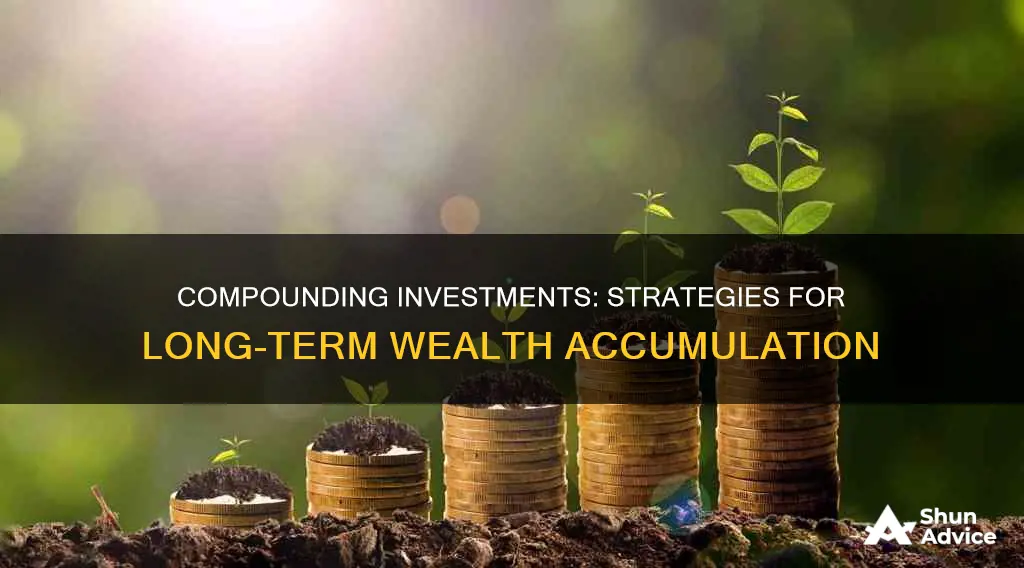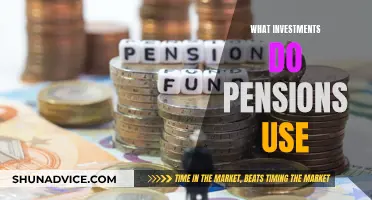
Compounding is a powerful investing concept that can help your money grow exponentially. It involves reinvesting your returns so that you earn money not just on your original investment, but also on the returns you've accumulated over time. This is often referred to as interest on interest or compound interest. For example, if you invest $1,000 and earn a 6% rate of return in the first year, you would have a total of $1,060. In the second year, you would earn a return on the full $1,060, and so on. Over time, compounding can lead to significant growth in your investments.
To take advantage of compounding, it's important to start investing early, reinvest your earnings, and maintain a long-term perspective. Different investment vehicles, such as certificates of deposit (CDs), high-yield savings accounts, bonds, and dividend stocks, can be used to compound your money. However, it's important to remember that compounding requires patience and consistency, and the impact of compounding may vary depending on economic conditions and market fluctuations.
What You'll Learn

The impact of compounding on investment returns
Compounding can have a significant impact on investment returns, allowing investors to grow their wealth over time. This process involves reinvesting the earnings from an initial investment to generate additional returns. The key advantage of compounding is that it enables investors to earn returns not only on their original investment but also on the accumulated earnings from previous periods. This leads to exponential growth in the long term.
For example, consider an investment of $1,000 earning a 6% rate of return. In the first year, the investor would make $60, resulting in a total investment value of $1,060. In the second year, the 6% return would be calculated based on the new total of $1,060, yielding $63.60 in interest. Thus, by the end of the second year, the total investment value would be $1,123.60. This demonstrates how compounding can lead to an increasing investment value over time.
The power of compounding is more evident when comparing two investors with the same initial investment and rate of return but different strategies. Suppose Investor A withdraws the interest earned each year, while Investor B reinvests the interest to benefit from compounding. Over 30 years, Investor A would earn a total of $21,000 in interest, while Investor B's earnings could potentially reach $66,123. This example highlights how compounding can result in significantly higher returns for investors who remain invested and reinvest their earnings.
Compounding is particularly effective over long periods, as the impact of reinvesting returns compounds over time. Starting early and maintaining a long-term investment horizon are crucial to maximizing the benefits of compounding. Additionally, consistent reinvestment of earnings, such as capital gains and dividends, is essential to achieving the exponential growth potential that compounding offers.
Compounding can be applied to various investment types, including savings accounts, certificates of deposit (CDs), high-yield savings accounts, bonds, dividend stocks, and real estate investment trusts (REITs). Each investment option has its own risk and return profile, and investors should carefully consider their financial goals and risk tolerance when deciding where to invest.
Public Zcash Investment: A Beginner's Guide to Getting Started
You may want to see also

Compounding periods
For example, consider an investment of $1 million that earns 20% per year. The future value, based on different compounding frequencies, is as follows:
- Annual compounding (1 compounding period per year): $1,200,000
- Semi-annual compounding (2 compounding periods per year): $1,210,000
- Quarterly compounding (4 compounding periods per year): $1,215,506
- Monthly compounding (12 compounding periods per year): $1,219,391
- Weekly compounding (52 compounding periods per year): $1,220,934
- Daily compounding (365 compounding periods per year): $1,221,336
As shown in the example, increasing the number of compounding periods per year results in a higher future value for the investment.
A Guide to Investing Cash in Australia
You may want to see also

Compounding and debt
Compounding can be a double-edged sword when it comes to debt. On the one hand, it can be used to pay off loans faster and save on total interest. On the other hand, if you only make minimum payments on high-interest loans or credit card debts, compounding can work against you, making it challenging to get out of debt.
How Compounding Works with Debt
When you borrow money, such as through a credit card, loan, or mortgage, you will be charged interest. This interest is often compounded, meaning it is calculated not just on the initial amount borrowed (the principal) but also on the interest that accumulates over time. The higher the number of compounding periods (e.g., daily, monthly, quarterly, or annually), the larger the effect of compounding, and the more debt grows over time.
For example, let's say you borrow $1,000 with a 20% annual interest rate compounded yearly. After the first year, you will owe $1,200 ($1,000 principal + $200 interest). In the second year, you will be charged 20% interest on this new amount. So, at the end of the second year, you will owe $1,440 ($1,200 principal + $240 interest). This process continues, and the debt grows exponentially.
Managing Debt with Compounding
The power of compounding can be harnessed to manage and reduce debt. Here are some strategies to consider:
- Make more than the minimum payment: By paying more than the minimum amount due, you can reduce the principal faster and save on total interest costs over the life of the loan.
- Reinvest windfalls: If you receive a windfall, such as a bonus or tax refund, consider using it to make a lump-sum payment towards your debt. This will reduce the principal and the total interest you will pay over time.
- Refinance at a lower rate: If you can refinance your debt at a lower interest rate, you can reduce the overall cost of the loan and the impact of compounding.
- Debt consolidation: Consolidating multiple debts into one loan with a lower interest rate can help simplify your payments and reduce the total interest paid over time.
Avoiding the Pitfalls of Compounding Debt
It's important to be mindful of how compounding can increase your debt burden over time. Here are some pitfalls to avoid:
- Making only the minimum payments: As demonstrated in the examples above, making only the minimum payments on a loan or credit card can result in a significant amount of interest accumulating over time, making it harder to get out of debt.
- High-interest credit card debt: Credit cards often have high-interest rates, and the interest charges are added to the principal balance, leading to even more interest being charged in a cycle that is difficult to break.
- Long-term loans: The longer the term of a loan, the more compounding periods there will be, and the more interest you will pay over the life of the loan. Whenever possible, opt for shorter loan terms to minimize the impact of compounding.
A Beginner's Guide to Trading with Ally Invest
You may want to see also

Understanding compound interest
Compound interest is a powerful investing concept that can help your money grow exponentially over time. It involves earning returns not just on your original investment but also on the returns you have received previously. This means that you make interest on your interest, and the effect of this is to magnify your returns over time.
To benefit from compound interest, you need to reinvest your returns back into your account. For example, let's say you invest $1,000 and earn a 6% rate of return in the first year. This would give you $60 in interest, bringing your total investment to $1,060. In the second year, you would earn a return on the full $1,060. If your return is again 6%, you would make $63.60, giving you a total investment of $1,123.60.
Over the long term, compound interest can significantly multiply your initial investment. Continuing with the example above, if you consistently earn a 6% return and reinvest your gains, by year 30, your annual earnings would be $325.10. This is more than five times the $60 return you earned in the first year, just from letting your money grow.
Compound interest is crucial in finance, and many investing strategies are motivated by the gains it can provide. For instance, some corporations offer dividend reinvestment plans (DRIPs) that allow investors to reinvest their cash dividends to purchase additional shares of stock. This compounds investor returns because the increased number of shares will consistently increase future income from dividend payouts, assuming steady dividends.
To maximise the benefits of compound interest, it's important to start investing early and maintain consistency. The key to success is patience and allowing your money to grow over time. Additionally, consider reinvesting your earnings automatically to make the process easier. Keep in mind that compound interest can work for or against you, depending on your financial situation. While it can boost the value of your assets, it can also increase the amount of debt you owe, as interest accumulates on unpaid principal and previous interest charges.
Smart Ways to Invest a Windfall of $150K Cash
You may want to see also

Strategies for maximising the power of compounding
Compounding is a powerful investing concept that can help you build wealth. It involves earning returns on both your original investment and the returns you have received previously. Here are some strategies to maximise the power of compounding:
- Start early: Compounding relies on time. The earlier you start investing, the more time your money has to grow. Consider investing in an account that earns interest or in an investment that pays dividends that can be reinvested.
- Reinvest your returns: To maximise compounding, reinvest your returns back into your account or investment. This will allow your earnings to compound and grow exponentially over time.
- Add new money regularly: Consider adding new money to your investment account regularly. This can be done through automatic transfers or split direct deposits.
- Consistency and patience: Maximising compounding requires consistency and patience. Stick to your investment strategy through economic troughs and peaks. Avoid the temptation to withdraw funds when they grow.
- Diversification: While compounding can boost your returns, it is important to diversify your investments to reduce risk. Consider allocating your portfolio across different asset classes and diversifying within each asset class.
- Reinvest dividends: If you receive dividends from your investments, reinvest them to purchase additional shares. This will increase your future income and further compound your returns.
Extra Cash: Where to Invest for Maximum Returns
You may want to see also
Frequently asked questions
Compounding is a process in which an asset's earnings are reinvested to generate more earnings over time. This is also known as compound interest.
Compounding involves reinvesting returns on an original investment and the returns received previously. For example, if you invest $1,000 and earn a 6% rate of return in the first year, you would make $60, bringing your total investment to $1,060. In the next year, you would earn a return on the total $1,060. If the return is again 6%, you would make $63.60, bringing your total investment to $1,123.60.
Some of the best compound interest investments include certificates of deposit (CDs), high-yield savings accounts, bonds and bond funds, and money market accounts.







